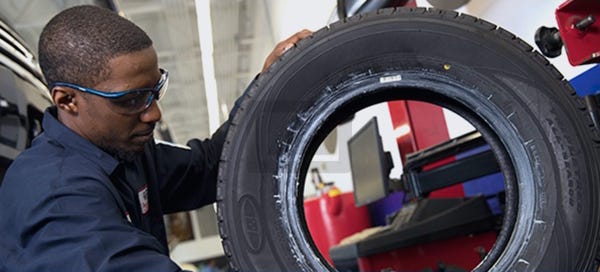Tire Solution: The Influence of Climate Condition
When it concerns making certain optimal efficiency and security when traveling, recognizing the impact of weather condition problems on tire solution is important. From scorching warmth to icy roads, each climate element can dramatically influence tire capability and total driving experience. By delving into the results of differing climate problems on tires, chauffeurs can gain valuable insights that may boost their vehicle's efficiency and durability. In this discussion, we will discover the elaborate connection between climate condition and tire service, dropping light on the value of weather-specific tire upkeep methods and considerations.
Warmth and Tire Performance
When subjected to high temperatures, tires experience modifications in efficiency that can substantially impact automobile safety and security and handling. The warm generated from long term driving or heat conditions causes the tire rubber to soften, leading to reduced step life and boosted wear. As the rubber ends up being softer, the tire's grip when driving lessens, influencing stopping distances and total grip. In extreme cases, too much warmth can also cause tire blowouts, posing a serious safety and security danger to the vehicle and its owners.

Winter Results
Cold climate problems can have a significant effect on tire efficiency and safety and security. In cold weather condition, tires might likewise shed air pressure a lot more swiftly, which can affect handling and fuel efficiency.
To minimize the impacts of chilly weather condition on tires, it is crucial to on a regular basis examine tire pressure and inflate them to the maker's recommended levels. Utilizing winter months or all-season tires created for winter problems can additionally boost traction and grasp on icy or snowy roadways. Proper tire maintenance, including normal inspections for wear and damage, becomes also much more important throughout cooler months to make certain optimum efficiency and security.
Rainy Issues Influence
Tires with worn-out treads are more susceptible to hydroplaning, where a layer of water constructs up between the roadway and the tire surface area, leading to loss of traction. To battle this, chauffeurs should regularly examine their tires for adequate step deepness and take into consideration investing in tires especially made for wet conditions.
Moreover, wet weather can additionally decrease exposure, making it testing for drivers to see the roadway ahead plainly (GMC Tire Service). In such problems, it is crucial to readjust driving speeds appropriately and preserve a secure following distance to enable sudden quits. Effectively inflated tires can likewise assist in maintaining control on wet roadways by providing far better handling and grasp
Snow and Tire Safety And Security
Snow-covered roads pose distinct challenges for chauffeurs, highlighting the importance of appropriate tire option and upkeep. When driving in snowy conditions, having the appropriate tires can make a considerable difference in safety and security Bonuses and performance. Winter tires are developed with special rubber compounds and tread patterns to supply far better grip on snow and ice compared to all-season tires. The deeper treads and sipes of winter season tires assist hold the roadway better, minimizing the threat of sliding and sliding.

Additionally, chauffeurs should think about setting up tire chains in extreme snowy problems. Tire chains offer extra grip by gripping the snow and ice, enhancing security and control. It is important to adhere to producer guidelines when installing and utilizing tire chains to prevent damage to the tires and car (GMC Tire Service). By selecting the ideal tires, maintaining appropriate rising cost of living, and taking into consideration additional traction help like tire chains, chauffeurs can enhance their security when browsing snow-covered roadways.
Weather-Related Tire Maintenance
When faced with numerous weather, correct tire maintenance ends up being a crucial element of automobile safety and performance. Weather-related tire upkeep encompasses a variety of techniques targeted at guaranteeing optimum tire function and long life in various weather condition situations. One key element of weather-related tire maintenance is tire stress guideline. Fluctuating temperatures can trigger tire stress to differ, influencing grip and fuel performance. On a regular basis checking and readjusting tire pressure according to supplier recommendations is necessary for safe driving in transforming weather conditions. Furthermore, tire tread depth plays a substantial duty in handling various weather components. Tires with sufficient step depth supply far better grip on wet or icy roads, lowering the threat of skidding or hydroplaning. When step wear reaches a particular deepness is vital for preserving traction and stability in negative climate, inspecting tire step frequently and changing tires. By prioritizing weather-related tire upkeep, chauffeurs can enhance security, improve automobile efficiency, and extend the life expectancy of their tires.
Conclusion
Finally, climate condition have a substantial influence on tire efficiency and safety. From heat impacting tire pressure and put on to cold climate decreasing traction, it is necessary to think about the climate when maintaining and making use of tires. Rainy problems can lower grip and result in hydroplaning, while snow can enhance the threat of accidents if tires are not appropriately equipped. Weather-related tire maintenance is critical in ensuring ideal efficiency and security on the see roadways.
In this conversation, we will certainly discover the elaborate relationship between weather condition conditions and tire service, shedding light on the significance of weather-specific tire maintenance practices and considerations.

Comments on “Boost Your Adventure: Count On Morris Tires for GMC Tires Service”